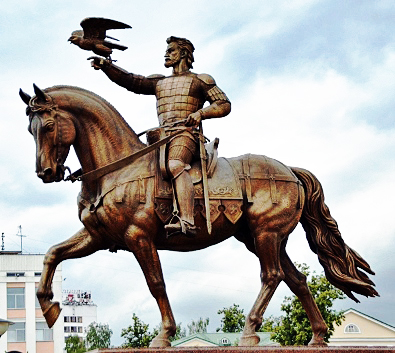| lithaz.org: home & art/culture events organizations publications |
| 5/15/2015 |
Lithuanian history:Algirdas
Algirdas was the son of Grand Duke Gediminas of Lithuania and his second wife Olga, the daughter of Prince Vsevolod of Smolensk. He was born in 1296 in Kernavė. In 1318 Algirdas married Maria, the daughter of Prince Yaroslav Vasilkovich of Vitebsk, who had no sons and received his new son-in-law in Vitebsk. Upon Yaroslav's death in 1320, Algirdas became the ruler of Vitebsk and a vassal of his father Gediminas. Gediminas added Borisov, near Minsk in today's Belarus, to the lands ruled by Algirdas. It is known that Maria was a devoted Orthodox Christian and some historians claim that Algirdas must have been baptized into the Orthodox faith, but there is no record of that. Algirdas and Maria had five sons - Andrei, Dmitri, Konstantine, Vladimir, and Theodore, and four daughters - Theodora, Agripina, Joan, and one of unknown name. To the east of Algirdas' lands, the rulers of Moscow were expanding their control over their East Slav neighbors, often with the help of the Tatar Khan of the Golden Horde. The smaller East Slav rulers, some of them related by marriage to Gediminas' family, sought military aliances with Gediminas' Lithuania and Algirdas became a key player in Lithuania's fight with Moscow and its supporters. Jaunutis, the youngest son of Gediminas' third wife, lived with his father in Vilnius and assumed the Grand Ducal title after Gediminas' death in 1341. Jaunutis, however, was not able to command the loyalty of his older half-brothers endangering the unity and survival of the Lithuanian state. In autumn of 1345, with the help of his younger brother Kęstutis, Algirdas removed Jaunutis from power in Vilnius, moved to Vilnius and became the Grand Duke of Lithuania. Opposition to Algirdas within the Gediminas family consisted of only Jaunutis and Narimantas. Both were given their own regions to rule and peace within the family soon returned. Kęstutis continued to reside in nearby Trakai and had the awesome responsibility of defending Lithuania from the Teutonic Knights, who were supported by the Catholic powers of Europe. Algirdas and Kęstutis worked so closely together, that foreign leaders were not always certain which one of them was the ruler of Lithuania. This close cooperation between the two of them lasted the entire Algirdas' life. After the death of his first wife Maria in 1349. Algirdas married Uliana, daughter of Aleksander Mikhailovich, Prince of Tver. During the 27 years of their marriage Algirdas and Uliana had 7 sons: Jogaila (-Vladislav) in 1351, Skirgaila (-Ivan) in 1453, Kaributas (-Dmitri), Lengvenis (-Simeon) in 1360, Karigaila (-Casimir), Vygundas (-Aleksander), and Švitrigaila (-Boleslav); and 3 daughters: Helen, Maria, and Aleksandra. Because these children were born in still pagan Lithuania, the sons were given pagan Lithuanian names. They converted to Christianity for political reasons later in their lives, receiving Christian baptismal names. Before his death at the age of 81 in 1377, Algirdas designated Jogaila, the oldest son of Uliana, as his successor in Vilnius and the next Grand Duke of Lithuania. This was done with Kęstutis' agreement. On May 24th Algirdas' body was burned on a funeral pyre in a sacred oak grove near Vilnius according to the pagan custom of the time. Cremated with Algirdas were eighteen horses and many of his valuables.
During the years of Algirdas' rule, Lithuanian state doubled in size by expanding into Slavic territories in the east and the south. (Click here to see map.) The fact that this was accomplished while Lithuania was under constant military pressure by the Teutonic Knights with the backing of Western Europe is a testament to the ability of Algirdas and Kęstutis as rulers. (Click here to read more history.) |
